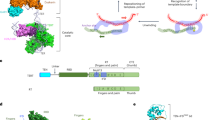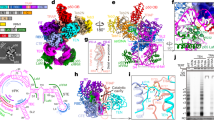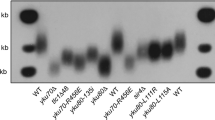Abstract
Telomerase is the ribonucleoprotein complex that adds telomeric repeats to the ends of chromosomes. Its protein subunit TERT is highly conserved among eukaryotes, whereas the RNA subunit varies greatly in size and sequence, hindering the identification of telomerase RNAs in some important model organisms. Here we report the identification and functional characterization of TER1, the telomerase RNA component from fission yeast Schizosaccharomyces pombe. Deletion of ter1+ caused progressive shortening of telomeres and cellular senescence followed by chromosome circularization. Interactions between Est1 and Trt1, the two known protein components of fission yeast telomerase, were dependent on TER1, supporting its role as a scaffold for the assembly of protein subunits. Using a series of template mutations, we show that translocation or dissociation site variability and template-primer slippage account for the sequence heterogeneity of fission yeast telomeres.
This is a preview of subscription content, access via your institution
Access options
Subscribe to this journal
Receive 12 print issues and online access
$189.00 per year
only $15.75 per issue
Buy this article
- Purchase on Springer Link
- Instant access to full article PDF
Prices may be subject to local taxes which are calculated during checkout






Similar content being viewed by others
Accession codes
References
Collins, K. The biogenesis and regulation of telomerase holoenzymes. Nat. Rev. Mol. Cell Biol. 7, 484–494 (2006).
Cech, T.R. Beginning to understand the end of the chromosome. Cell 116, 273–279 (2004).
Nakamura, T.M. et al. Telomerase catalytic subunit homologs from fission yeast and human. Science 277, 955–959 (1997).
Lingner, J., Cech, T.R., Hughes, T.R. & Lundblad, V. Three Ever Shorter Telomere (EST) genes are dispensable for in vitro yeast telomerase activity. Proc. Natl. Acad. Sci. USA 94, 11190–11195 (1997).
Beernink, H.T., Miller, K., Deshpande, A., Bucher, P. & Cooper, J.P. Telomere maintenance in fission yeast requires an Est1 ortholog. Curr. Biol. 13, 575–580 (2003).
Reichenbach, P. et al. A human homolog of yeast Est1 associates with telomerase and uncaps chromosome ends when overexpressed. Curr. Biol. 13, 568–574 (2003).
Snow, B.E. et al. Functional conservation of the telomerase protein Est1p in humans. Curr. Biol. 13, 698–704 (2003).
Greider, C.W. & Blackburn, E.H. A telomeric sequence in the RNA of Tetrahymena telomerase required for telomere repeat synthesis. Nature 337, 331–337 (1989).
Feng, J. et al. The RNA component of human telomerase. Science 269, 1236–1241 (1995).
Chen, J.L., Blasco, M.A. & Greider, C.W. Secondary structure of vertebrate telomerase RNA. Cell 100, 503–514 (2000).
McEachern, M.J. & Blackburn, E.H. Runaway telomere elongation caused by telomerase RNA gene mutations. Nature 376, 403–409 (1995).
Singer, M.S. & Gottschling, D.E. TLC1: template RNA component of Saccharomyces cerevisiae telomerase. Science 266, 404–409 (1994).
Vulliamy, T. et al. Disease anticipation is associated with progressive telomere shortening in families with dyskeratosis congenita due to mutations in TERC. Nat. Genet. 36, 447–449 (2004).
Cooper, J.P., Nimmo, E.R., Allshire, R.C. & Cech, T.R. Regulation of telomere length and function by a Myb-domain protein in fission yeast. Nature 385, 744–747 (1997).
Kanoh, J. & Ishikawa, F. spRap1 and spRif1, recruited to telomeres by Taz1, are essential for telomere function in fission yeast. Curr. Biol. 11, 1624–1630 (2001).
Baumann, P. & Cech, T.R. Pot1, the putative telomere end-binding protein in fission yeast and humans. Science 292, 1171–1175 (2001).
Hiraoka, Y., Henderson, E. & Blackburn, E.H. Not so peculiar: fission yeast telomere repeats. Trends Biochem. Sci. 23, 126 (1998).
Trujillo, K.M., Bunch, J.T. & Baumann, P. Extended DNA binding site in Pot1 broadens sequence specificity to allow recognition of heterogeneous fission yeast telomeres. J. Biol. Chem. 280, 9119–9128 (2005).
Haering, C.H., Nakamura, T.M., Baumann, P. & Cech, T.R. Analysis of telomerase catalytic subunit mutants in vivo and in vitro in Schizosaccharomyces pombe. Proc. Natl. Acad. Sci. USA 97, 6367–6372 (2000).
Lue, N.F. & Peng, Y. Identification and characterization of a telomerase activity from Schizosaccharomyces pombe. Nucleic Acids Res. 25, 4331–4337 (1997).
Naito, T., Matsuura, A. & Ishikawa, F. Circular chromosome formation in a fission yeast mutant defective in two ATM homologues. Nat. Genet. 20, 203–206 (1998).
Nakamura, T.M., Cooper, J.P. & Cech, T.R. Two modes of survival of fission yeast without telomerase. Science 282, 493–496 (1998).
Nakamura, T.M., Moser, B.A. & Russell, P. Telomere binding of checkpoint sensor and DNA repair proteins contributes to maintenance of functional fission yeast telomeres. Genetics 161, 1437–1452 (2002).
Dandjinou, A.T. et al. A phylogenetically based secondary structure for the yeast telomerase RNA. Curr. Biol. 14, 1148–1158 (2004).
Seto, A.G., Zaug, A.J., Sobel, S.G., Wolin, S.L. & Cech, T.R. Saccharomyces cerevisiae telomerase is an Sm small nuclear ribonucleoprotein particle. Nature 401, 177–180 (1999).
Jady, B.E., Bertrand, E. & Kiss, T. Human telomerase RNA and box H/ACA scaRNAs share a common Cajal body-specific localization signal. J. Cell Biol. 164, 647–652 (2004).
Lei, M., Podell, E.R., Baumann, P. & Cech, T.R. DNA self-recognition in the structure of Pot1 bound to telomeric single-stranded DNA. Nature 426, 198–203 (2003).
Zappulla, D.C., Goodrich, K. & Cech, T.R. A miniature yeast telomerase RNA functions in vivo and reconstitutes activity in vitro. Nat. Struct. Mol. Biol. 12, 1072–1077 (2005).
Zappulla, D.C. & Cech, T.R. Yeast telomerase RNA: a flexible scaffold for protein subunits. Proc. Natl. Acad. Sci. USA 101, 10024–10029 (2004).
Livengood, A.J., Zaug, A.J. & Cech, T.R. Essential regions of Saccharomyces cerevisiae telomerase RNA: separate elements for Est1p and Est2p interaction. Mol. Cell. Biol. 22, 2366–2374 (2002).
Chapon, C., Cech, T.R. & Zaug, A.J. Polyadenylation of telomerase RNA in budding yeast. RNA 3, 1337–1351 (1997).
Mitchell, J.R., Cheng, J. & Collins, K. A box H/ACA small nucleolar RNA-like domain at the human telomerase RNA 3′ end. Mol. Cell. Biol. 19, 567–576 (1999).
Fu, D. & Collins, K. Human telomerase and Cajal body ribonucleoproteins share a unique specificity of Sm protein association. Genes Dev. 20, 531–536 (2006).
Forstemann, K. & Lingner, J. Molecular basis for telomere repeat divergence in budding yeast. Mol. Cell. Biol. 21, 7277–7286 (2001).
Baumann, P. & Cech, T.R. Protection of telomeres by the Ku protein in fission yeast. Mol. Biol. Cell 11, 3265–3275 (2000).
Brun, C., Dubey, D.D. & Huberman, J.A. pDblet, a stable autonomously replicating shuttle vector for Schizosaccharomyces pombe. Gene 164, 173–177 (1995).
Church, G.M. & Gilbert, W. Genomic sequencing. Proc. Natl. Acad. Sci. USA 81, 1991–1995 (1984).
Li, S.G., Zhou, H., Luo, Y.P., Zhang, P. & Qu, L.H. Identification and functional analysis of 20 Box H/ACA small nucleolar RNAs (snoRNAs) from Schizosaccharomyces pombe. J. Biol. Chem. 280, 16446–16455 (2005).
Zaug, A.J., Linger, J. & Cech, T.R. Method for determining RNA 3′ ends and application to human telomerase RNA. Nucleic Acids Res. 24, 532–533 (1996).
Bunch, J.T., Bae, N.S., Leonardi, J. & Baumann, P. Distinct requirements for Pot1 in limiting telomere length and maintaining chromosome stability. Mol. Cell. Biol. 25, 5567–5578 (2005).
Acknowledgements
We thank X. Wang for her help and advice, G. Zakian and C. Webb for their willingness to coordinate publication of similar, independently obtained results, J. Huberman (Roswell Park Cancer Institute) for plasmid pDblet, M. Cook and E. Glynn for computational help, D. Baumann, C. Haering, X. Wang and D. Zapulla for critical reading of the manuscript and the Stowers Institute Molecular Biology Facility staff for site-directed mutagenesis and sequencing. We also thank T. Cech, M. Blanchette and D. Zapulla for discussions. Work in our laboratory is supported by the Stowers Institute for Medical Research, a Basil O'Connor Starter Scholar Research Award to P.B. (5-FY03-134) and the Pew Scholars Program in Biomedical Sciences.
Author information
Authors and Affiliations
Contributions
J.L. isolated and cloned the RNA subunit and performed immunoprecipitation and telomerase assays; J.A.B. contributed DNA constructs, fission yeast strains and telomere length analyses; J.T.B. generated northern blots and telomere sequence data; and P.B. designed the experiments and contributed RACE data, telomerase assays and pulsed-field gel electrophoresis analysis.
Corresponding author
Supplementary information
Supplementary Text and Figures
Supplementary Figures 1–4 (PDF 845 kb)
Rights and permissions
About this article
Cite this article
Leonardi, J., Box, J., Bunch, J. et al. TER1, the RNA subunit of fission yeast telomerase. Nat Struct Mol Biol 15, 26–33 (2008). https://doi.org/10.1038/nsmb1343
Received:
Accepted:
Published:
Issue Date:
DOI: https://doi.org/10.1038/nsmb1343
This article is cited by
-
The methyl phosphate capping enzyme Bmc1/Bin3 is a stable component of the fission yeast telomerase holoenzyme
Nature Communications (2022)
-
Identification of telomerase RNAs in species of the Yarrowia clade provides insights into the co-evolution of telomerase, telomeric repeats and telomere-binding proteins
Scientific Reports (2019)
-
Pof8 is a La-related protein and a constitutive component of telomerase in fission yeast
Nature Communications (2018)
-
LARP7-like protein Pof8 regulates telomerase assembly and poly(A)+TERRA expression in fission yeast
Nature Communications (2018)
-
Diverse mechanisms for spliceosome-mediated 3′ end processing of telomerase RNA
Nature Communications (2015)



